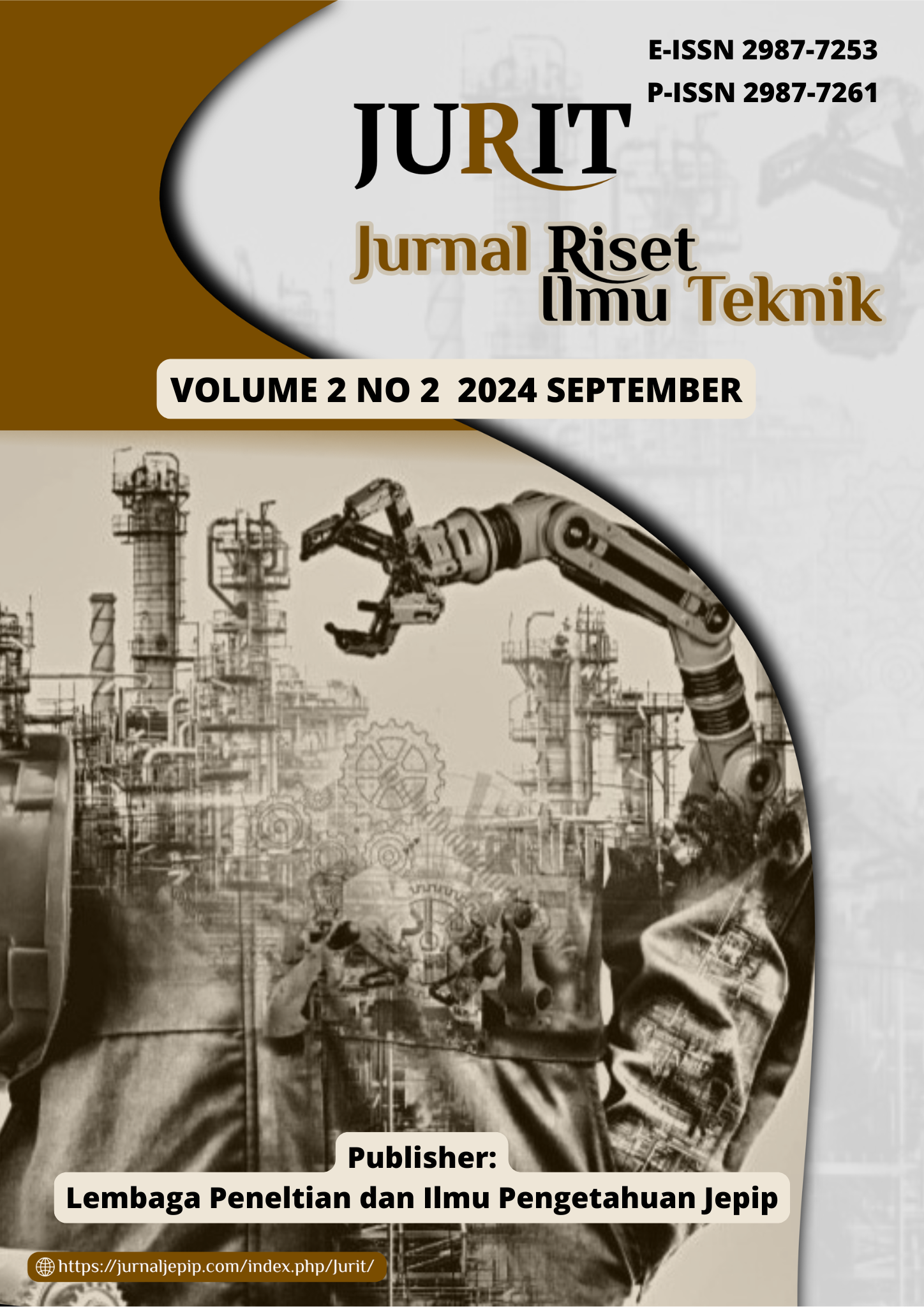Optimizing Hospital Pharmaceutical Warehouse Operations Using Discrete Event Simulation
DOI:
https://doi.org/10.59976/jurit.v2i2.97Abstract
This study aims to analyze and optimize the operational performance of the pharmaceutical logistics warehouse at Hospital Yogyakarta using a Discrete Event Simulation (DES) approach. Preliminary observations revealed a significant workload accumulation during peak hours (09:00–10:55), leading to drug distribution delays, a 10–15% weekly discrepancy between physical and system stock data, and a 12% decline in patient satisfaction. Data were collected through direct work time measurements and secondary hospital records, then modeled using an Activity Cycle Diagram (ACD) and simulated with Arena software. Three improvement scenarios were tested: (1) reassigning goods and invoice verification tasks to the ordering operator, (2) adding one new operator dedicated to the posting activity in the system, and (3) combining both strategies. Simulation results indicate that Alternative III provides the best performance, reducing the average cycle time from 411.4 minutes to 65.57 minutes per cycle, improving productivity by up to 99%, and achieving balanced workloads among operators. These findings demonstrate that DES-based modeling is an effective tool for identifying bottlenecks and designing process improvements without requiring costly technological investment. This research contributes to the field of hospital pharmaceutical logistics management by offering an evidence-based decision-making framework to enhance operational efficiency and service quality sustainably.
References
N. Cao, “Priority-based replenishment policy for robotic dispensing in central fill pharmacy systems: a simulation-based study,” Health Care Manag. Sci., vol. 26, no. 2, pp. 344–362, 2023, doi: 10.1007/s10729-023-09630-x.
H. Jiang, “Promoting continuity of care in nurse-patient assignment: A multiple objective heuristic algorithm,” Decis. Support Syst., vol. 167, 2023, doi: 10.1016/j.dss.2023.113926.
N. U. I. Hossain, “Application of systems modeling language (SysML) and discrete event simulation to address patient waiting time issues in healthcare,” Smart Heal., vol. 29, 2023, doi: 10.1016/j.smhl.2023.100403.
Y. Zhang, “Cost-effectiveness of guideline-based care provision for patients with diabetes-related foot ulcers: A modelled analysis using discrete event simulation,” Diabet. Med., vol. 40, no. 1, 2023, doi: 10.1111/dme.14961.
S. Fichera, “Application of lean techniques and simulation to improve efficiency of the oncology department,” Int. J. Serv. Oper. Manag., vol. 44, no. 2, pp. 270–292, 2023, doi: 10.1504/IJSOM.2021.10037906.
S. Datta, “A multi-objective optimization model for outpatient care delivery with service fairness,” Bus. Process Manag. J., vol. 29, no. 3, pp. 630–652, 2023, doi: 10.1108/BPMJ-07-2022-0335.
G. P. Romani, “Evaluating post-earthquake functionality and surge capacity of hospital emergency departments using discrete event simulation,” Earthq. Spectra, vol. 39, no. 1, pp. 402–433, 2023, doi: 10.1177/87552930221128607.
T. Zhang, “Data-Driven Modeling and Analysis for COVID-19 Pandemic Hospital Beds Planning,” IEEE Trans. Autom. Sci. Eng., vol. 20, no. 3, pp. 1551–1564, 2023, doi: 10.1109/TASE.2022.3224171.
M. Taleb, “An integrated approach of discrete event simulation and a non-radial super efficiency data envelopment analysis for performance evaluation of an emergency department,” Expert Syst. Appl., vol. 220, 2023, doi: 10.1016/j.eswa.2023.119653.
Z. Song, “Multi-stage and multi-objective design optimization for improving resilience of base-isolated hospital buildings,” Eng. Struct., vol. 304, 2024, doi: 10.1016/j.engstruct.2024.117644.
E. Bolandifar, “Modeling abandonment behavior among patients,” Eur. J. Oper. Res., vol. 306, no. 1, pp. 243–254, 2023, doi: 10.1016/j.ejor.2022.08.023.
K. H. Chang, “Simulation optimization for stochastic casualty collection point location and resource allocation problem in a mass casualty incident,” Eur. J. Oper. Res., vol. 309, no. 3, pp. 1237–1262, 2023, doi: 10.1016/j.ejor.2023.01.065.
B. Wijnen, “Fenfluramine for Treating Dravet Syndrome: An Evidence Review Group Perspective of a NICE Single Technology Appraisal,” 2023. doi: 10.1007/s40273-022-01209-8.
E. Meephu, “Enhancement of Intra-hospital patient transfer in medical center hospital using discrete event system simulation,” PLoS One, vol. 18, no. 4, 2023, doi: 10.1371/journal.pone.0282592.
B. Shahverdi, “Models for Assessing Strategies for Improving Hospital Capacity for Handling Patients during a Pandemic,” Disaster Med. Public Health Prep., vol. 17, no. 2, 2023, doi: 10.1017/dmp.2022.12.
A. T. Campos, “Integrating computer simulation and the normalized normal constraint method to plan a temporary hospital for COVID-19 patients,” J. Oper. Res. Soc., vol. 74, no. 2, pp. 562–573, 2023, doi: 10.1080/01605682.2022.2083989.
S. M. Moghadas, “Cost-effectiveness of Prefusion F Protein-based Vaccines Against Respiratory Syncytial Virus Disease for Older Adults in the United States,” Clin. Infect. Dis., vol. 78, no. 5, pp. 1328–1335, 2024, doi: 10.1093/cid/ciad658.
Z. Jia, “Spatial decision support systems for hospital layout design: A review,” 2023. doi: 10.1016/j.jobe.2023.106042.
A. Bhosekar, “A discrete event simulation model for coordinating inventory management and material handling in hospitals,” Ann. Oper. Res., vol. 320, no. 2, pp. 603–630, 2023, doi: 10.1007/s10479-020-03865-5.
A. Metzner, “Electrophysiology lab efficiency comparison between cryoballoon and point-by-point radiofrequency ablation: a German sub-analysis of the FREEZE Cohort study,” BMC Cardiovasc. Disord., vol. 23, no. 1, 2023, doi: 10.1186/s12872-022-03015-8.
S. L. Busschaert, “Deep Inspiration Breath Hold in Left-Sided Breast Radiotherapy: A Balance Between Side Effects and Costs,” Jacc Cardiooncology, vol. 6, no. 4, pp. 514–525, 2024, doi: 10.1016/j.jaccao.2024.04.009.
C. Zou, “The Impact of the Variability of Patient Flow and Service Time on the Efficiency of Large-Scale Outpatient Systems,” IEEE Trans. Comput. Soc. Syst., vol. 10, no. 3, pp. 1230–1240, 2023, doi: 10.1109/TCSS.2021.3137930.
S. Hutspardol, “The estimated negative impacts on the red blood cell inventory of reducing shelf-life at two large health authorities in British Columbia, Canada, using a discrete-event simulation model,” Vox Sang., vol. 118, no. 5, pp. 376–383, 2023, doi: 10.1111/vox.13417.
H. Squires, “What impact would reducing low-acuity attendance have on emergency department length of stay? A discrete event simulation modelling study,” Emerg. Med. J., vol. 41, no. 1, pp. 27–33, 2023, doi: 10.1136/emermed-2023-213314.
H. Hassanzadeh, “New bed configurations and discharge timing policies: A hospital-wide simulation,” EMA Emerg. Med. Australas., vol. 35, no. 3, pp. 434–441, 2023, doi: 10.1111/1742-6723.14135.
Y. Tian, “The impact of alternate level of care on access block and operational strategies to reduce emergency wait times: a multi-center simulation study,” Can. J. Emerg. Med., vol. 25, no. 7, pp. 608–616, 2023, doi: 10.1007/s43678-023-00514-1.
M. Ortiz-Barrios, “Artificial intelligence and discrete-event simulation for capacity management of intensive care units during the Covid-19 pandemic: A case study,” J. Bus. Res., vol. 160, 2023, doi: 10.1016/j.jbusres.2023.113806.
H. Hassanzadeh, “A discrete event simulation for improving operating theatre efficiency,” Int. J. Health Plann. Manage., vol. 38, no. 2, pp. 360–379, 2023, doi: 10.1002/hpm.3589.
A. Shoukat, “Cost-effectiveness analysis of nirsevimab and maternal RSVpreF vaccine strategies for prevention of Respiratory Syncytial Virus disease among infants in Canada: a simulation study,” Lancet Reg. Heal. Am., vol. 28, 2023, doi: 10.1016/j.lana.2023.100629.
T. R. Bovim, “Simulating emergency patient flow during the COVID-19 pandemic,” J. Simul., vol. 17, no. 4, pp. 407–421, 2023, doi: 10.1080/17477778.2021.2015259.
J. Possik, “An Agent-Based Modeling and Virtual Reality Application Using Distributed Simulation: Case of a COVID-19 Intensive Care Unit,” IEEE Trans. Eng. Manag., vol. 70, no. 8, pp. 2931–2943, 2023, doi: 10.1109/TEM.2022.3195813.
A. Harper, “Development and application of simulation modelling for orthopaedic elective resource planning in England,” BMJ Open, vol. 13, no. 12, 2023, doi: 10.1136/bmjopen-2023-076221.
M. Ordu, “A comprehensive and integrated hospital decision support system for efficient and effective healthcare services delivery using discrete event simulation,” Healthc. Anal., vol. 4, 2023, doi: 10.1016/j.health.2023.100248.
J. Y. Perez-Tezoco, “Hospital reconversion in response to the COVID-19 pandemic using simulation and multi-objective genetic algorithms,” Comput. Ind. Eng., vol. 182, 2023, doi: 10.1016/j.cie.2023.109408.
A. Angelopoulou, “Hybrid modelling and simulation of the effect of vaccination on the COVID-19 transmission,” J. Simul., vol. 18, no. 1, pp. 88–99, 2024, doi: 10.1080/17477778.2022.2062260.
E. Ouda, “Comprehensive review and future research agenda on discrete-event simulation and agent-based simulation of emergency departments,” 2023. doi: 10.1016/j.simpat.2023.102823.
K. Rahmani, “Assessing the effects of data drift on the performance of machine learning models used in clinical sepsis prediction,” Int. J. Med. Inform., vol. 173, 2023, doi: 10.1016/j.ijmedinf.2022.104930.
Z. R. Rise, “An integrated HFMEA simulation-based multi-objective optimisation model to improve the performances of hospitals: A case study,” J. Simul., vol. 17, no. 4, pp. 422–443, 2023, doi: 10.1080/17477778.2021.2015260.
E. Redondo, “A simulation model for predicting hospital occupancy for Covid-19 using archetype analysis,” Healthc. Anal., vol. 3, 2023, doi: 10.1016/j.health.2023.100197.
S. M. Qureshi, “Developing a simulation tool to quantify biomechanical load and quality of care in nursing,” Ergonomics, vol. 66, no. 7, pp. 886–903, 2023, doi: 10.1080/00140139.2022.2113921.
Downloads
Published
How to Cite
Issue
Section
License
Copyright (c) 2024 Aldi Musliadin, Dwi Apriadi

This work is licensed under a Creative Commons Attribution 4.0 International License.





















